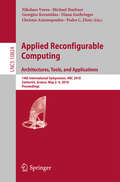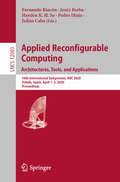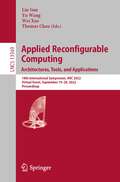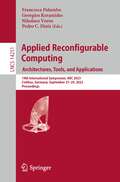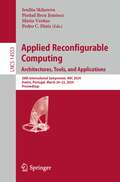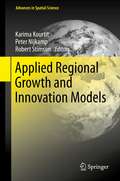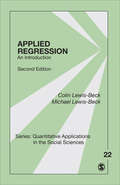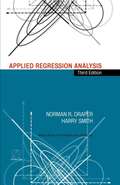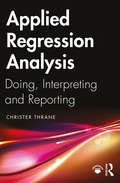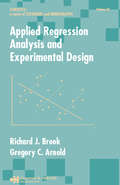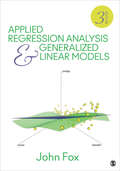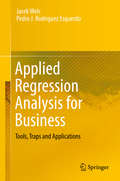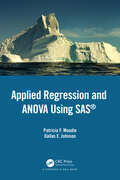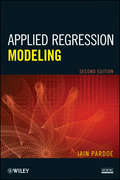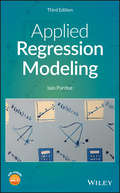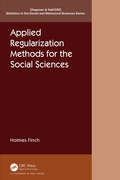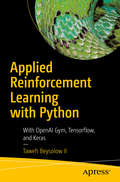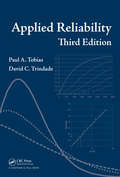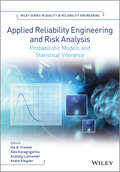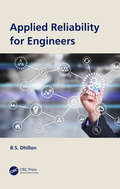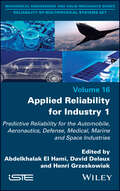- Table View
- List View
Applied Reconfigurable Computing. Architectures, Tools, and Applications: 14th International Symposium, Arc 2018, Santorini, Greece, May 2-4, 2018, Proceedings (Lecture Notes In Computer Science #10824)
by Pedro C. Diniz Diana Goehringer Michael Huebner Nikolaos Voros Georgios Keramidas Christos AntonopoulosThis book constitutes the proceedings of the 14th International Conference on Applied Reconfigurable Computing, ARC 2018, held in Santorini, Greece, in May 2018. <P><P> The 29 full papers and 22 short presented in this volume were carefully reviewed and selected from 78 submissions. In addition, the volume contains 9 contributions from research projects. The papers were organized in topical sections named: machine learning and neural networks; FPGA-based design and CGRA optimizations; applications and surveys; fault-tolerance, security and communication architectures; reconfigurable and adaptive architectures; design methods and fast prototyping; FPGA-based design and applications; and special session: research projects.
Applied Reconfigurable Computing. Architectures, Tools, and Applications: 16th International Symposium, ARC 2020, Toledo, Spain, April 1–3, 2020, Proceedings (Lecture Notes in Computer Science #12083)
by Pedro Diniz Fernando Rincón Jesús Barba Hayden K. H. So Julián CabaThis book constitutes the proceedings of the 16th International Symposium on Applied Reconfigurable Computing, ARC 2020, held in Toledo, Spain, in April 2020. The 18 full papers and 11 poster presentations presented in this volume were carefully reviewed and selected from 40 submissions. The papers are organized in the following topical sections: design methods & tools; design space exploration & estimation techniques; high-level synthesis; architectures; applications.
Applied Reconfigurable Computing. Architectures, Tools, and Applications: 18th International Symposium, ARC 2022, Virtual Event, September 19–20, 2022, Proceedings (Lecture Notes in Computer Science #13569)
by Lin Gan Yu Wang Wei Xue Thomas ChauThis book constitutes the proceedings of the 18th International Symposium on Applied Reconfigurable Computing, ARC 2022, held as a virtual event, in September 2022. The 13 full papers presented in this volume were reviewed and selected from 16 submissions. The papers cover a broad spectrum of applications of reconfigurable computing, from driving assistance, data and graph processing acceleration, computer security to the societal relevant topic of supporting early diagnosis of Covid infectious conditions.
Applied Reconfigurable Computing. Architectures, Tools, and Applications: 19th International Symposium, ARC 2023, Cottbus, Germany, September 27–29, 2023, Proceedings (Lecture Notes in Computer Science #14251)
by Francesca Palumbo Georgios Keramidas Nikolaos Voros Pedro C. DinizThis book constitutes the proceedings of the 19th International Symposium on Applied Reconfigurable Computing, ARC 2023, which was held in Cottbus, Germany, in September 2023.The 18 full papers presented in this volume were reviewed and selected from numerous submissions. The proceedings also contain 4 short PhD papers. The contributions were organized in topical sections as follows: Design methods and tools; applications; architectures; special session: near and in-memory computing; and PhD forum papers.
Applied Reconfigurable Computing. Architectures, Tools, and Applications: 20th International Symposium, ARC 2024, Aveiro, Portugal, March 20–22, 2024, Proceedings (Lecture Notes in Computer Science #14553)
by Iouliia Skliarova Piedad Brox Jiménez Mário Véstias Pedro C. DinizThis LNCS conference volume constitutes the proceedings of the 20th International Symposium, ARC 2024, in Aveiro, Portugal, in March 2024. The 16 full papers together with 5 papers from the technical program included in this volume were carefully reviewed and selected from 24 submissions. The conference focuses on the application and development of reconfigurable computing techniques, fault-tolerance, data, and graph processing acceleration to computer security.
Applied Regional Growth and Innovation Models (Advances in Spatial Science)
by Peter Nijkamp Karima Kourtit Robert StimsonModern spatial-economic systems exhibit a high degree of dynamics as a result of technological progress, demographic evolution or global change. In the past decade, an avalanche of new regional economic growth and innovation models has been put forward. This volume contains a unique collection of operational models of a strong applied nature that may be seen as original landmarks in the rich tradition of spatial-economic growth modelling. The contributors are recognized experts from different parts of the world.
Applied Regression: An Introduction (Quantitative Applications in the Social Sciences #22)
by Michael S. Lewis-Beck Colin Lewis-BeckKnown for its readability and clarity, this Second Edition of the best-selling Applied Regression provides an accessible introduction to regression analysis for social scientists and other professionals who want to model quantitative data. After covering the basic idea of fitting a straight line to a scatter of data points, the text uses clear language to explain both the mathematics and assumptions behind the simple linear regression model. Authors Colin Lewis-Beck and Michael Lewis-Beck then cover more specialized subjects of regression analysis, such as multiple regression, measures of model fit, analysis of residuals, interaction effects, multicollinearity, and prediction. Throughout the text, graphical and applied examples help explain and demonstrate the power and broad applicability of regression analysis for answering scientific questions.
Applied Regression: An Introduction (Quantitative Applications in the Social Sciences #22)
by Michael S. Lewis-Beck Colin Lewis-BeckKnown for its readability and clarity, this Second Edition of the best-selling Applied Regression provides an accessible introduction to regression analysis for social scientists and other professionals who want to model quantitative data. After covering the basic idea of fitting a straight line to a scatter of data points, the text uses clear language to explain both the mathematics and assumptions behind the simple linear regression model. Authors Colin Lewis-Beck and Michael Lewis-Beck then cover more specialized subjects of regression analysis, such as multiple regression, measures of model fit, analysis of residuals, interaction effects, multicollinearity, and prediction. Throughout the text, graphical and applied examples help explain and demonstrate the power and broad applicability of regression analysis for answering scientific questions.
Applied Regression Analysis (Wiley Series in Probability and Statistics #326)
by Norman R. Draper Harry SmithAn outstanding introduction to the fundamentals of regression analysis-updated and expanded The methods of regression analysis are the most widely used statistical tools for discovering the relationships among variables. This classic text, with its emphasis on clear, thorough presentation of concepts and applications, offers a complete, easily accessible introduction to the fundamentals of regression analysis. Assuming only a basic knowledge of elementary statistics, Applied Regression Analysis, Third Edition focuses on the fitting and checking of both linear and nonlinear regression models, using small and large data sets, with pocket calculators or computers. This Third Edition features separate chapters on multicollinearity, generalized linear models, mixture ingredients, geometry of regression, robust regression, and resampling procedures. Extensive support materials include sets of carefully designed exercises with full or partial solutions and a series of true/false questions with answers. All data sets used in both the text and the exercises can be found on the companion disk at the back of the book. For analysts, researchers, and students in university, industrial, and government courses on regression, this text is an excellent introduction to the subject and an efficient means of learning how to use a valuable analytical tool. It will also prove an invaluable reference resource for applied scientists and statisticians.
Applied Regression Analysis: Doing, Interpreting and Reporting
by Christer ThraneThis book is an introduction to regression analysis, focusing on the practicalities of doing regression analysis on real-life data. Contrary to other textbooks on regression, this book is based on the idea that you do not necessarily need to know much about statistics and mathematics to get a firm grip on regression and perform it to perfection. This non-technical point of departure is complemented by practical examples of real-life data analysis using statistics software such as Stata, R and SPSS. Parts 1 and 2 of the book cover the basics, such as simple linear regression, multiple linear regression, how to interpret the output from statistics programs, significance testing and the key regression assumptions. Part 3 deals with how to practically handle violations of the classical linear regression assumptions, regression modeling for categorical y-variables and instrumental variable (IV) regression. Part 4 puts the various purposes of, or motivations for, regression into the wider context of writing a scholarly report and points to some extensions to related statistical techniques. This book is written primarily for those who need to do regression analysis in practice, and not only to understand how this method works in theory. The book’s accessible approach is recommended for students from across the social sciences.
Applied Regression Analysis and Experimental Design (Statistics: A Series Of Textbooks And Monographs #62)
by Richard J. Brook Gregory C. ArnoldFor a solid foundation of important statistical methods, the concise, single-source text unites linear regression with analysis of experiments and provides students with the practical understanding needed to apply theory in real data analysis problems.Stressing principles while keeping computational and theoretical details at a manageable level, Applied Regression Analysis and Experimental Design features an emphasis on vector geometry and least squares to unify and provide an intuitive basis for most topics covered… abundant examples and exercises using real-life data sets clearly illustrating practical of data analysis…essential exposure to MINITAB and GENSTAT computer packages , including computer printouts…and important background material such as vector and matrix properties and the distributional properties of quadratic forms.Designed to make theory work for students, this clearly written, easy-to-understand work serves as the ideal texts for courses Regression, Experimental Design, and Linear Models in a broad range of disciplines. Moreover, applied statisticians will find the book a useful reference for the general application of the linear model.
Applied Regression Analysis and Generalized Linear Models
by Dr John FoxCombining a modern, data-analytic perspective with a focus on applications in the social sciences, the Third Edition of Applied Regression Analysis and Generalized Linear Models provides in-depth coverage of regression analysis, generalized linear models, and closely related methods, such as bootstrapping and missing data. Updated throughout, this Third Edition includes new chapters on mixed-effects models for hierarchical and longitudinal data. Although the text is largely accessible to readers with a modest background in statistics and mathematics, author John Fox also presents more advanced material in optional sections and chapters throughout the book.
Applied Regression Analysis and Generalized Linear Models
by Dr John FoxCombining a modern, data-analytic perspective with a focus on applications in the social sciences, the Third Edition of Applied Regression Analysis and Generalized Linear Models provides in-depth coverage of regression analysis, generalized linear models, and closely related methods, such as bootstrapping and missing data. Updated throughout, this Third Edition includes new chapters on mixed-effects models for hierarchical and longitudinal data. Although the text is largely accessible to readers with a modest background in statistics and mathematics, author John Fox also presents more advanced material in optional sections and chapters throughout the book.
Applied Regression Analysis and Generalized Linear Models
by John FoxCombining a modern, data-analytic perspective with a focus on applications in the social sciences, the Third Edition of Applied Regression Analysis and Generalized Linear Models provides in-depth coverage of regression analysis, generalized linear models, and closely related methods, such as bootstrapping and missing data. <P><P> Updated throughout, this Third Edition includes new chapters on mixed-effects models for hierarchical and longitudinal data. Although the text is largely accessible to readers with a modest background in statistics and mathematics, author John Fox also presents more advanced material in optional sections and chapters throughout the book.
Applied Regression Analysis for Business: Tools, Traps and Applications
by Jacek Welc Pedro J. Rodriguez EsquerdoThis book offers hands-on statistical tools for business professionals by focusing on the practical application of a single-equation regression. The authors discuss commonly applied econometric procedures, which are useful in building regression models for economic forecasting and supporting business decisions. A significant part of the book is devoted to traps and pitfalls in implementing regression analysis in real-world scenarios. The book consists of nine chapters, the final two of which are fully devoted to case studies. Today's business environment is characterised by a huge amount of economic data. Making successful business decisions under such data-abundant conditions requires objective analytical tools, which can help to identify and quantify multiple relationships between dozens of economic variables. Single-equation regression analysis, which is discussed in this book, is one such tool. The book offers a valuable guide and is relevant in various areas of economic and business analysis, including marketing, financial and operational management.
Applied Regression and ANOVA Using SAS
by Patricia F. Moodie Dallas E. JohnsonApplied Regression and ANOVA Using SAS® has been written specifically for non-statisticians and applied statisticians who are primarily interested in what their data are revealing. Interpretation of results are key throughout this intermediate-level applied statistics book. The authors introduce each method by discussing its characteristic features, reasons for its use, and its underlying assumptions. They then guide readers in applying each method by suggesting a step-by-step approach while providing annotated SAS programs to implement these steps.Those unfamiliar with SAS software will find this book helpful as SAS programming basics are covered in the first chapter. Subsequent chapters give programming details on a need-to-know basis. Experienced as well as entry-level SAS users will find the book useful in applying linear regression and ANOVA methods, as explanations of SAS statements and options chosen for specific methods are provided.Features:•Statistical concepts presented in words without matrix algebra and calculus•Numerous SAS programs, including examples which require minimum programming effort to produce high resolution publication-ready graphics•Practical advice on interpreting results in light of relatively recent views on threshold p-values, multiple testing, simultaneous confidence intervals, confounding adjustment, bootstrapping, and predictor variable selection•Suggestions of alternative approaches when a method’s ideal inference conditions are unreasonable for one’s dataThis book is invaluable for non-statisticians and applied statisticians who analyze and interpret real-world data. It could be used in a graduate level course for non-statistical disciplines as well as in an applied undergraduate course in statistics or biostatistics.
Applied Regression Modeling
by Iain PardoePraise for the First Edition"The attention to detail is impressive. The book is very well written and the author is extremely careful with his descriptions . . . the examples are wonderful." --The American StatisticianFully revised to reflect the latest methodologies and emerging applications, Applied Regression Modeling, Second Edition continues to highlight the benefits of statistical methods, specifically regression analysis and modeling, for understanding, analyzing, and interpreting multivariate data in business, science, and social science applications.The author utilizes a bounty of real-life examples, case studies, illustrations, and graphics to introduce readers to the world of regression analysis using various software packages, including R, SPSS, Minitab, SAS, JMP, and S-PLUS. In a clear and careful writing style, the book introduces modeling extensions that illustrate more advanced regression techniques, including logistic regression, Poisson regression, discrete choice models, multilevel models, and Bayesian modeling.In addition, the Second Edition features clarification and expansion of challenging topics, such as:Transformations, indicator variables, and interactionTesting model assumptionsNonconstant varianceAutocorrelationVariable selection methodsModel building and graphical interpretationThroughout the book, datasets and examples have been updated and additional problems are included at the end of each chapter, allowing readers to test their comprehension of the presented material. In addition, a related website features the book's datasets, presentation slides, detailed statistical software instructions, and learning resources including additional problems and instructional videos.With an intuitive approach that is not heavy on mathematical detail, Applied Regression Modeling, Second Edition is an excellent book for courses on statistical regression analysis at the upper-undergraduate and graduate level. The book also serves as a valuable resource for professionals and researchers who utilize statistical methods for decision-making in their everyday work.
Applied Regression Modeling: A Business Approach
by Iain PardoeMaster the fundamentals of regression without learning calculus with this one-stop resource The newly and thoroughly revised 3rd Edition of Applied Regression Modeling delivers a concise but comprehensive treatment of the application of statistical regression analysis for those with little or no background in calculus. Accomplished instructor and author Dr. Iain Pardoe has reworked many of the more challenging topics, included learning outcomes and additional end-of-chapter exercises, and added coverage of several brand-new topics including multiple linear regression using matrices. The methods described in the text are clearly illustrated with multi-format datasets available on the book's supplementary website. In addition to a fulsome explanation of foundational regression techniques, the book introduces modeling extensions that illustrate advanced regression strategies, including model building, logistic regression, Poisson regression, discrete choice models, multilevel models, Bayesian modeling, and time series forecasting. Illustrations, graphs, and computer software output appear throughout the book to assist readers in understanding and retaining the more complex content. Applied Regression Modeling covers a wide variety of topics, like: Simple linear regression models, including the least squares criterion, how to evaluate model fit, and estimation/prediction Multiple linear regression, including testing regression parameters, checking model assumptions graphically, and testing model assumptions numerically Regression model building, including predictor and response variable transformations, qualitative predictors, and regression pitfalls Three fully described case studies, including one each on home prices, vehicle fuel efficiency, and pharmaceutical patches Perfect for students of any undergraduate statistics course in which regression analysis is a main focus, Applied Regression Modeling also belongs on the bookshelves of non-statistics graduate students, including MBAs, and for students of vocational, professional, and applied courses like data science and machine learning.
Applied Regularization Methods for the Social Sciences (Chapman & Hall/CRC Statistics in the Social and Behavioral Sciences)
by Holmes FinchResearchers in the social sciences are faced with complex data sets in which they have relatively small samples and many variables (high dimensional data). Unlike the various technical guides currently on the market, Applied Regularization Methods for the Social Sciences provides and overview of a variety of models alongside clear examples of hands-on application. Each chapter in this book covers a specific application of regularization techniques with a user-friendly technical description, followed by examples that provide a thorough demonstration of the methods in action. Key Features: Description of regularization methods in a user friendly and easy to read manner Inclusion of regularization-based approaches for a variety of statistical analyses commonly used in the social sciences, including both univariate and multivariate models Fully developed extended examples using multiple software packages, including R, SAS, and SPSS Website containing all datasets and software scripts used in the examples Inclusion of both frequentist and Bayesian regularization approaches Application exercises for each chapter that instructors could use in class, and independent researchers could use to practice what they have learned from the book
Applied Rehabilitation Counseling
by T. F. Riggar Dennis R. Maki Arnold W. WolfA comprehensive introduction to the practice of rehabilitation counseling. Appropriate for professionals and those preparing to enter the rehabilitation counseling field.
Applied Reinforcement Learning with Python: With OpenAI Gym, Tensorflow, and Keras
by Taweh Beysolow IIDelve into the world of reinforcement learning algorithms and apply them to different use-cases via Python. This book covers important topics such as policy gradients and Q learning, and utilizes frameworks such as Tensorflow, Keras, and OpenAI Gym. Applied Reinforcement Learning with Python introduces you to the theory behind reinforcement learning (RL) algorithms and the code that will be used to implement them. You will take a guided tour through features of OpenAI Gym, from utilizing standard libraries to creating your own environments, then discover how to frame reinforcement learning problems so you can research, develop, and deploy RL-based solutions. What You'll LearnImplement reinforcement learning with Python Work with AI frameworks such as OpenAI Gym, Tensorflow, and KerasDeploy and train reinforcement learning–based solutions via cloud resourcesApply practical applications of reinforcement learning Who This Book Is For Data scientists, machine learning engineers and software engineers familiar with machine learning and deep learning concepts.
Applied Reliability
by Paul A. Tobias David TrindadeSince the publication of the second edition of Applied Reliability in 1995, the ready availability of inexpensive, powerful statistical software has changed the way statisticians and engineers look at and analyze all kinds of data. Problems in reliability that were once difficult and time consuming even for experts can now be solved with a few well
Applied Reliability Engineering and Risk Analysis
by Alex Karagrigoriou Anatoly Lisnianski Andre V. Kleyner Ilia B. FrenkelThis complete resource on the theory and applications of reliability engineering, probabilistic models and risk analysis consolidates all the latest research, presenting the most up-to-date developments in this field.With comprehensive coverage of the theoretical and practical issues of both classic and modern topics, it also provides a unique commemoration to the centennial of the birth of Boris Gnedenko, one of the most prominent reliability scientists of the twentieth century.Key features include:expert treatment of probabilistic models and statistical inference from leading scientists, researchers and practitioners in their respective reliability fieldsdetailed coverage of multi-state system reliability, maintenance models, statistical inference in reliability, systemability, physics of failures and reliability demonstrationmany examples and engineering case studies to illustrate the theoretical results and their practical applications in industryApplied Reliability Engineering and Risk Analysis is one of the first works to treat the important areas of degradation analysis, multi-state system reliability, networks and large-scale systems in one comprehensive volume. It is an essential reference for engineers and scientists involved in reliability analysis, applied probability and statistics, reliability engineering and maintenance, logistics, and quality control. It is also a useful resource for graduate students specialising in reliability analysis and applied probability and statistics.Dedicated to the Centennial of the birth of Boris Gnedenko, renowned Russian mathematician and reliability theorist
Applied Reliability for Engineers
by B.S. DhillonEngineering systems and products are an important element of the world economy and each year billions of dollars are spent to develop, manufacture, operate, and maintain systems and products around the globe. Because of this, global competition is requiring reliability professionals to work closely with other departments involved in engineering development during the product design and manufacturing phase. Applied Reliability for Engineers is an attempt to meet the need for a single volume that addresses a wide range of applied reliability topics. The material is treated in such a manner that the reader will require no previous knowledge to understand the text. The sources of most of the information presented are given in a reference section at the end of each chapter. At appropriate places, the book contains examples along with their solutions. At the end of each chapter there are numerous problems to test reader comprehension. This volume is thus suitable for use as a textbook as well as for reference. Applied Reliability for Engineers is useful to design professionals, system engineers, reliability specialists, graduate and senior undergraduate students, researchers and instructors of reliability engineering, and engineers-at-large.
Applied Reliability for Industry 1: Predictive Reliability for the Automobile, Aeronautics, Defense, Medical, Marine and Space Industries
by Abdelkhalak El Hami David Delaux Henri GrzeskowiakApplied Reliability for Industry 1 illustrates the multidisciplinary state-of-the-art science of predictive reliability. Many experts are now convinced that reliability is not limited to statistical sciences. In fact, many different disciplines interact in order to bring a product to its highest possible level of reliability, made available through today's technologies, developments and production methods. These three books, of which this is the first, propose new methods for analyzing the lifecycle of a system, enabling us to record the development phases according to development time and levels of complexity for its integration. Predictive reliability, as particularly focused on in Applied Reliability for Industry 1, examines all the engineering activities used to estimate or predict the reliability performance of the final mechatronic system.
